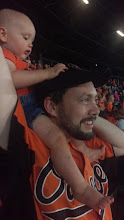 I have to admit that I'm somewhat amused by the randomness that takes hold of this blog. Believe it or not, I often go to painstaking lengths to insert variety when it comes to choosing daily subjects. I try to feature new players, which becomes an increasing challenge fifteen months into the life of this ongoing project. Failing that, I at least try to post a card from a set I haven't featured. If I can kill two birds with one stone, all the better. In one of my more obsessive-compulsive bits of plotting, I even try to alternate between pitchers and position players every other day. For some reason, I usually seem to slant towards position players. But sometimes I want to jump on a snippet of news that I've heard about a player, or I just find myself staring down writers' block and have to grab the first interesting-looking card I see.
I have to admit that I'm somewhat amused by the randomness that takes hold of this blog. Believe it or not, I often go to painstaking lengths to insert variety when it comes to choosing daily subjects. I try to feature new players, which becomes an increasing challenge fifteen months into the life of this ongoing project. Failing that, I at least try to post a card from a set I haven't featured. If I can kill two birds with one stone, all the better. In one of my more obsessive-compulsive bits of plotting, I even try to alternate between pitchers and position players every other day. For some reason, I usually seem to slant towards position players. But sometimes I want to jump on a snippet of news that I've heard about a player, or I just find myself staring down writers' block and have to grab the first interesting-looking card I see.A quick check of my tags shows that the most frequently used card set is the 1991 Crown/Coca-Cola All-Time Orioles set, with 11 posts. That makes sense, as it's a great oddball set that features a whopping 500-plus cards of every player in Orioles history from 1954 through early 1991. The runners-up are 1983 Topps and 2007 Upper Deck, with five each.
Cal Ripken, Jr. is unsurprising as the top featured player, again with eleven appearances. The most surprising high-ranked player is Adam Loewen, who I am now featuring for the fifth time. Pretty heady stuff for an injury-prone failed #1 draft pick who is reinventing himself as a first baseman in the Toronto organization as we speak. But he had an eventful year, with his participation in the Orioles Magic video and his position switch. That's the way my mind works sometimes.
I wonder who will be a recurring character on this blog as 2009 keeps chugging along.
































